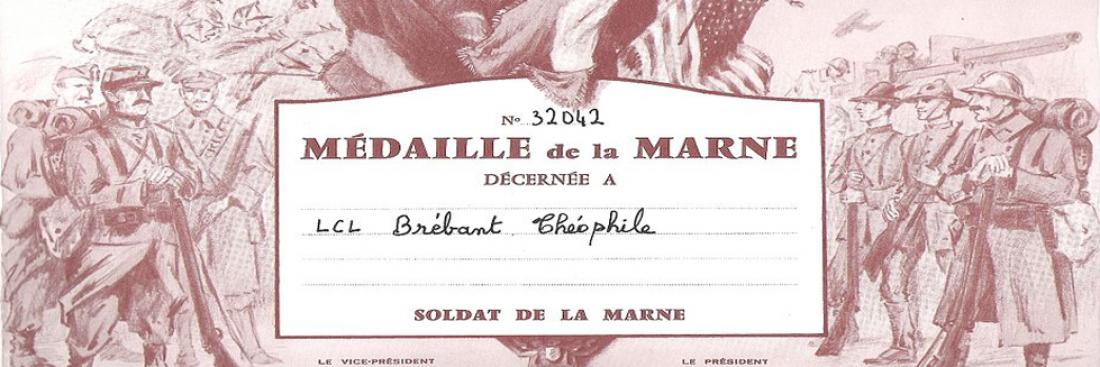La première bataille de la Marne

Corps 1
A vast theatre of operations stretching for about 300 kilometres, the "Battle of the Marne" allowed a seriously compromised military position to be restored. A place of relentless fighting, it opened the way to an all-out and industrial war that was to become the conflict of 1914-1918. On the 5th September 1914, in his Châtillon-sur-Seine headquarters, the generalissimo Joseph Joffre issued his orders of the day. They were circulated early in the morning the following day, the 6th September. This message, devoid of all ambiguity, is now famous: "At the point of engaging in a battle on which the fate of the country depends, it is important to remind everyone that it is no longer a time for looking back. Every effort must be made to attack and push back the enemy. A troop that can advance no further must, at all costs, defend the captured ground and face getting killed rather than retreat. In the current circumstances, no failure will be tolerated." From the 6th September the battle of the Marne developed and, through an extraordinary effort, French troops restored a seriously compromised military position.How did it reach this point? At the start of the war, convictions were rock solid, as much for the decision makers, both military and civilian, as for public opinion and amongst the mobilised troops. The war would be short. According to the enormous progress achieved in armaments over the last thirty or so years, nobody could imagine that the national armies would have to suffer the ordeal of being under fire long-term. The war would probably be setled by a few decisive battles and we would be home to finish the harvest. Such certainty partly explains the "acceptance" of the war by the poilus (slang term for a French soldier).
Corps 2
The French plan of attack (Plan XVII) was a failure and was quickly to be abandoned. The first French offensives in the Alsace came to a sudden end, whilst the Schlieffen plan, applied with substantial modifications by young Moltke, ran its relentless course. But, from the 24th August, even though French troops were in retreat everywhere - which never turned into a collapse, thanks to drastic measures that were strictly applied - Joffre made the first decisions that were to allow organisation of the counter-offensive later on.
Today, a certain number of recent works have renewed the approach to the battle of the Marne. It is now pointless trying to determine who, Gallieni or Joffre, deserves the merit for having launched the counter-offensive that was to re-establish the French military position. Only Joseph Joffre as General in chief commanded a complete view of a battlefield stretching for several hundred kilometres, although several generals played important roles in recovering the Marne. It is therefore certainly Joffre who deserves credit for the whole manoeuvre, due to his comprehensive vision and the organisation of his strategic transport, as well as his iron grip.
A vast theatre of operations stretching over 300 km
The name of the "Battle of the Marne" is a little deceptive. In fact, fighting raged across about three hundred kilometres, from Senlis to Verdun. Even the chronology of the battle is also variable, depending on what are considered to be the western and the eastern parts of this long front. In the west, the end of fighting was signalled by the recapture of the château of Mondement on the 9th September. From Sompuis to Verdun in the east, fighting continued until the 12th September. The "battle of the Marne" was therefore, in fact, a vast theatre of operations with one part overlapping another. Other names could have been used to qualify this collection of a series of battles. The stronghold of Verdun and its surroundings in particular were of vital importance along the whole of the front. In September 1914, Verdun marked for the Germans a real point of inflection between the marching wing of the Schlieffen plan and the German left wing, whose task was to put pressure on the French in Lorraine and on the Hauts-de-Meuse. For the French, on the orders of General Coutanceau, the position of Verdun, which was becoming increasingly isolated, had to hold out in order to protect the centre of the front. Between the 10th and the 13th September, fighting was fierce around La Vaux Marie and Souilly. Spread across about 300 kilometres of front, the so-called battles "of the Marne" were at the same time interdependent on each other. It was a veritable chain of extremely violent thrusts, the two opponents seeking to sever what were judged to be the weakest links at certain points in the battle.But, the symbolism of the battle came as a result of the fighting along the Ourcq canal and in the centre. On the Ourcq, Maunoury's army, which was in difficulty, received reinforcements from the 7th Infantry Division, of which 5 battalions (just 5,500 men) were transported in Paris taxis requisitioned by Gallieni. In the centre, the Germans concentrated their main effort on Foch's 9th army. Foch's right hand side had difficulty containing the furious attacks from von Hausen's army. Mondement, a nodal point in their defences, held up well, thanks to Humbert's Moroccan troops and Grossetti's artillery. The château of Mondement was recaptured on the evening of the 9th September by the Zouaves and Bretons of the 77th infantry regiment.
The battle of the Marne was an important time in the warring violence of the 1914 campaign. From the start, it was all about firepower, surprising even the soldiers themselves. The battles have to be viewed from the dual perspective of the Germans and the Franco-British.From the point of view of the chiefs, Wednesday September 9th was without doubt the day that assumed the most importance in this battle. As well as the fighting at Mondement, it was the same day that Lieutenant Colonel Hentsch, Moltke's deputy to Klück (Moltke's general headquarters having stayed in Luxembourg), put pressure on the latter, by pointing out the danger of his position in the front line and by convincing him to stop the fighting. The fact that a lowly Lieutenant Colonel could be responsible for the fate of several armies is symptomatic of the failings in the German command during this period. Moreover, Hentsch, who had been given the authority for this by the sick Moltke, was to take decisions out of proportion with his status.
From the point of view of the soldiers on the ground, the impact of these battles was terrible. The armies moved quickly, with adversaries surrounding each other and sometimes overtaking each other. It was during the fighting of September 1914, some of which took place at night, that brutal behaviour came to be incorporated into the attitudes of soldiers on both sides. The fighting at La Vaux Marie and Vassincourt was, broadly speaking, as violent as that at Marais de Saint-Gond and Mondement.
There was therefore something new about this fighting. Never, in battles in the past, even the most recent ones, had so many men fought so fiercely and with such equipment at their disposal on such a broad front. Because of this, the first battle of the Marne of September 1914 really did open the way to an all-out and industrial war that was to become the conflict of 1914-1918. The human cost was enormous. At the two extremes, both chronologically and geographically, of the battle of the Marne, two intellectuals were killed; they were both symbolic of the French youthfulness that believed it was fighting for the development of civilisation. On the 5th September at Villeroy, Lieutenant Charles Péguy was killed leading his soldiers of the 276th Infantry Regiment. On the 22nd September, Lieutenant Alain-Fournier, the author of The Grand Meaulnes (The Wanderer), died during the fighting at Saint-Rémy la Calonne, just one day after taking command of the 23rd company of the 288th Infantry Regiment. Lieutenants were commanding companies and captains commanding battalions, which said a lot about the extent of losses of junior officers.
In the battles of August and September 1914 alone, more than 250,000 young French men died, more than died during the whole of the battle of Verdun in a year. We can now understand just how much of a sense of mourning pervaded French society from the end of 1914. This made it almost impossible to negotiate a solution with the enemy, so that such horrendous losses would not come to be regarded as pointless.The first reports paid tribute to the various soldiers in this initial battle of 1914. Everybody was aware of the defeated von Klück's words of praise for the true victor, namely the basic French soldier, "that men who had been retreating for a fortnight, that men lying on the ground and half-dead from fatigue could take up their guns again and attack when the bugle sounded, is one thing that we Germans had never learned to expect: it was an eventuality that had never been considered in our training schools for war." The communiqué that Joffre sent to the minister for war on the 13th September 1914 ended with his own words: "The government of the Republic can be proud of the army it has organised."
From reconciliation to shared remembrance
Today, remembrance of the battle of the Marne is a shared by all at the graveside. The "Mondement 1914" association, along with others, is proof of the great power of remembrance. For some years, delegations of former enemies have been joining together at the beginning of September to share their feelings through remembrance.It is no longer a time for fighting. It is time for understanding the events that led to such a violent explosion. It is also a time for paying tribute to the hundreds of thousands of men who suffered on both sides for reasons that people today find difficult to understand. It is up to the historians to make sense of something that is not always obvious to people in the modern age. For a brief moment in history, this same area of the Champagne region, which had been put to the test by the battle of the Marne and throughout the whole of the Great War, was also witness to the first signs of Franco-German reconciliation. Meetings between de Gaulle and Adenauer at Colombey, in the Haute-Marne, laid the foundations of a close union that continues today within the structure of Europe. On the 8th July 1962, Reims cathedral, which suffered in the German bombardment and the fire of 19th September 1914, was host to the two great French and German statesmen for a "masse for peace", thus putting an end to the spiral of war that had started with the pain and violence of 1914.


